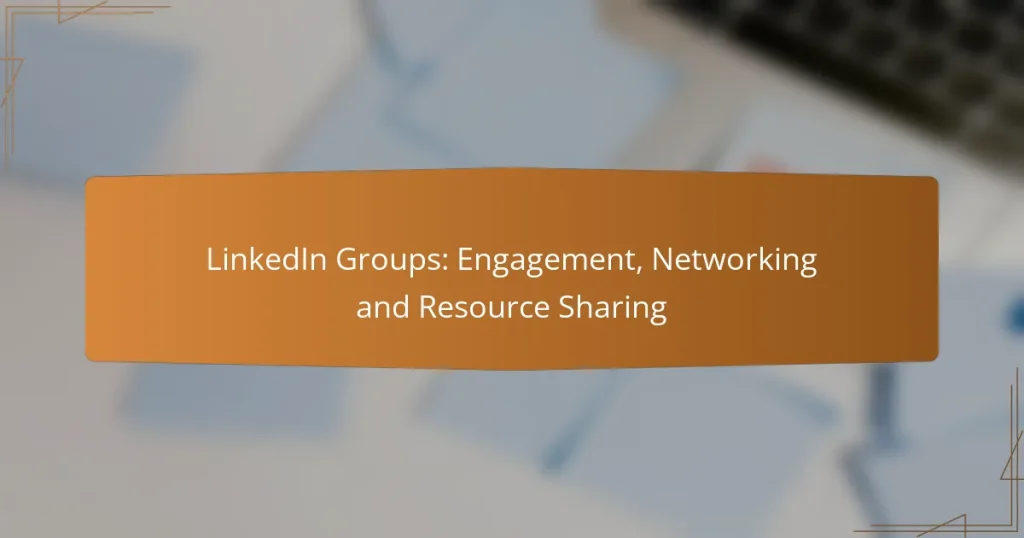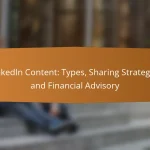LinkedIn Groups provide a dynamic platform for engagement, networking, and resource sharing among professionals. By participating in discussions and sharing insights, you can expand your network, enhance your visibility, and establish your expertise within your industry. Selecting the right groups that align with your interests is crucial for maximizing these benefits and fostering meaningful connections.
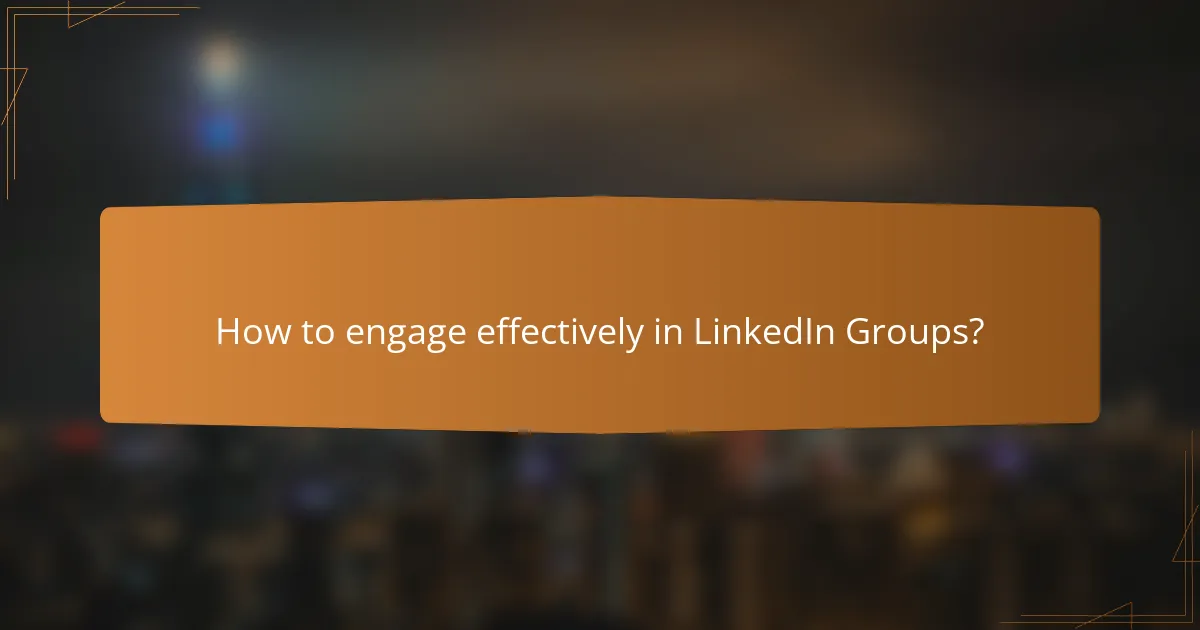
How to engage effectively in LinkedIn Groups?
Engaging effectively in LinkedIn Groups involves consistent interaction, sharing valuable insights, and fostering meaningful discussions. By actively participating and contributing, you can enhance your professional network and establish your expertise.
Post valuable content regularly
Regularly posting valuable content is crucial for keeping group members engaged. Share articles, case studies, or personal experiences that provide insights relevant to the group’s focus. Aim for a frequency of at least once a week to maintain visibility and relevance.
Consider using a mix of formats, such as text posts, images, or videos, to cater to different preferences. Always ensure that your content is informative and aligns with the interests of the group members.
Participate in discussions actively
Active participation in discussions helps build relationships and establish your presence in the group. Respond to comments on your posts and engage with others’ content by sharing your thoughts or asking follow-up questions. This two-way interaction fosters a sense of community.
Make it a habit to check the group regularly for new discussions, aiming to contribute to at least a few conversations each week. This not only enhances your visibility but also demonstrates your commitment to the group’s objectives.
Ask questions to spark conversations
Asking questions is an effective way to stimulate conversation within LinkedIn Groups. Pose open-ended questions that encourage members to share their opinions or experiences. This can lead to richer discussions and provide diverse perspectives on relevant topics.
For example, you might ask, “What challenges have you faced in implementing new technologies in your industry?” This invites members to share their insights and can lead to valuable exchanges of ideas.
Share industry insights and resources
Sharing industry insights and resources positions you as a knowledgeable member of the group. Provide updates on trends, new research, or tools that can benefit others. This not only adds value but also encourages reciprocal sharing from other members.
Consider creating a monthly roundup of useful articles or resources that you can share with the group. This can become a reliable source of information for members and enhance your reputation as a thought leader.
Utilize polls for member feedback
Using polls is a great way to engage group members and gather feedback on various topics. Polls can help gauge opinions on industry trends, preferred content types, or upcoming events. This interactive element can increase participation and provide insights into member preferences.
Keep polls simple and relevant, with clear options for responses. For instance, you could ask, “Which topic would you like to see covered in our next discussion?” This not only engages members but also helps tailor future content to their interests.

What are the benefits of networking in LinkedIn Groups?
Networking in LinkedIn Groups offers significant advantages, including access to a diverse pool of industry professionals, collaboration opportunities, enhanced visibility for your personal brand, and valuable learning experiences. Engaging in these groups can lead to meaningful connections and resources that can advance your career.
Access to industry professionals
LinkedIn Groups connect you with industry professionals who share your interests and expertise. This access can facilitate introductions to key players in your field, allowing you to expand your network beyond your immediate contacts.
Participating actively in discussions can increase your chances of being noticed by influencers and decision-makers. Consider reaching out to group members for informational interviews or mentorship opportunities to further enhance your professional connections.
Opportunities for collaboration
Networking in LinkedIn Groups often leads to collaboration opportunities on projects, research, or initiatives. By engaging with group members, you can identify potential partners who complement your skills and expertise.
Look for discussions that highlight shared interests or challenges, and propose collaborative solutions. This proactive approach can result in joint ventures that benefit all parties involved, fostering a sense of community and mutual support.
Enhanced visibility for personal brand
Active participation in LinkedIn Groups can significantly boost your visibility and credibility within your industry. By sharing insights, commenting on posts, and contributing valuable content, you position yourself as a knowledgeable resource.
Consider creating original posts or articles that address common challenges in your field. This not only showcases your expertise but also encourages engagement from other group members, further enhancing your personal brand.
Learning from peers and experts
LinkedIn Groups provide a platform for learning from both peers and industry experts. Engaging in discussions allows you to gain insights into emerging trends, best practices, and innovative solutions relevant to your field.
Take advantage of webinars, Q&A sessions, and shared resources within the group. Actively seeking feedback and asking questions can deepen your understanding and help you stay informed about industry developments.

How to choose the right LinkedIn Groups?
Choosing the right LinkedIn Groups involves identifying communities that align with your professional interests and goals. Focus on groups that foster active discussions and contain members relevant to your industry.
Identify groups aligned with your industry
Start by searching for groups related to your specific field or profession. Use keywords that reflect your industry to find relevant communities. For example, if you work in digital marketing, look for groups that focus on SEO, content marketing, or social media strategies.
Additionally, consider the group’s purpose and the topics discussed. Groups that regularly post about industry trends, challenges, and innovations will provide valuable insights and networking opportunities.
Evaluate group activity and engagement levels
Assess the level of activity within a group by checking the frequency of posts and comments. A vibrant group typically has daily discussions and numerous interactions among members. Aim for groups that have at least a few posts each week to ensure ongoing engagement.
Look for groups where members actively respond to questions and share resources. High engagement levels indicate a supportive community that can enhance your networking and learning experience.
Check member demographics for relevance
Review the demographics of group members to ensure they align with your professional goals. Look for groups that include professionals from your industry, as well as those from related fields who can provide diverse perspectives.
Consider the size of the group as well; smaller groups may offer more personalized interactions, while larger groups can provide a broader network. Aim for groups with a balanced mix of experienced professionals and newcomers to foster meaningful connections.
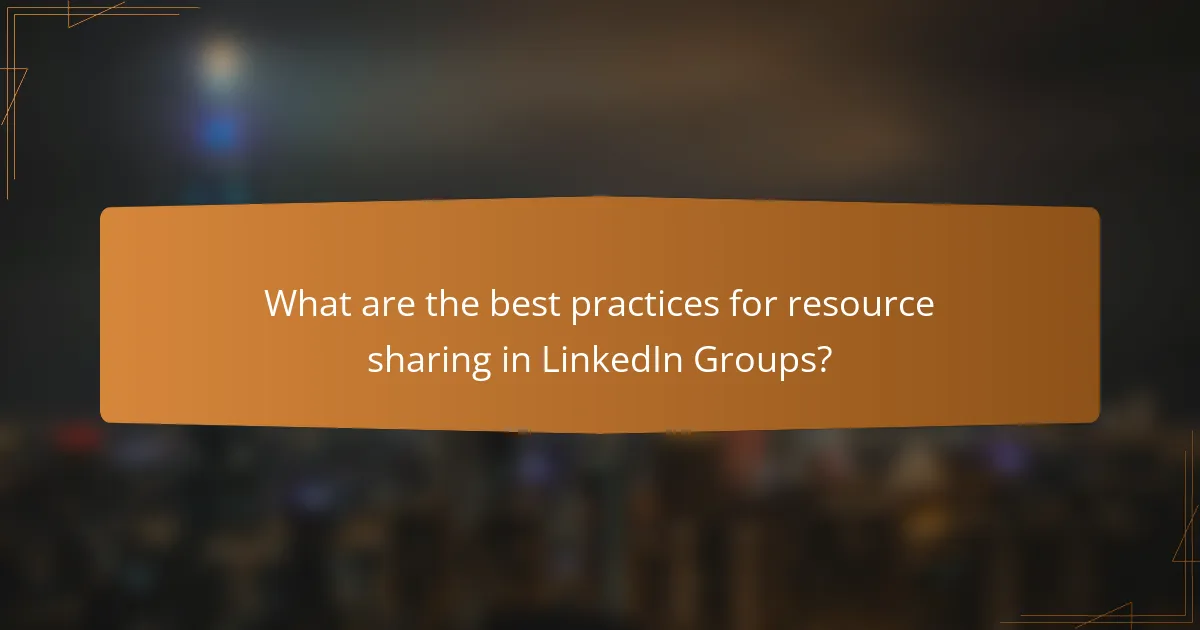
What are the best practices for resource sharing in LinkedIn Groups?
Effective resource sharing in LinkedIn Groups involves providing valuable content while fostering engagement and discussion. By following best practices, members can enhance their visibility and establish meaningful connections within their professional community.
Share original content to establish authority
Sharing original content, such as articles, case studies, or insights, positions you as a knowledgeable member of the group. This not only showcases your expertise but also encourages others to engage with your posts. Aim to share content that reflects your unique perspective or experiences in your field.
Consider creating a mix of formats, such as written posts, infographics, or videos, to cater to different preferences within the group. Regularly contributing original content can significantly boost your credibility and authority among peers.
Provide context for shared resources
When sharing resources, always include context to help group members understand their relevance. Briefly explain why the resource is valuable and how it can be applied in their professional lives. This approach encourages more meaningful interactions and discussions around the shared content.
For example, if you share a report on industry trends, summarize key findings and suggest how they might impact your group members’ work. This not only adds value but also invites others to share their thoughts and experiences related to the topic.
Encourage feedback on shared materials
Inviting feedback on the resources you share fosters a collaborative environment and encourages dialogue. Ask specific questions about the shared content to prompt responses and engage group members in discussion. This can lead to richer conversations and deeper insights.
For instance, after sharing an article, you might ask, “What are your thoughts on the strategies discussed?” or “How have you implemented similar approaches in your work?” This not only enhances engagement but also builds a sense of community within the group.
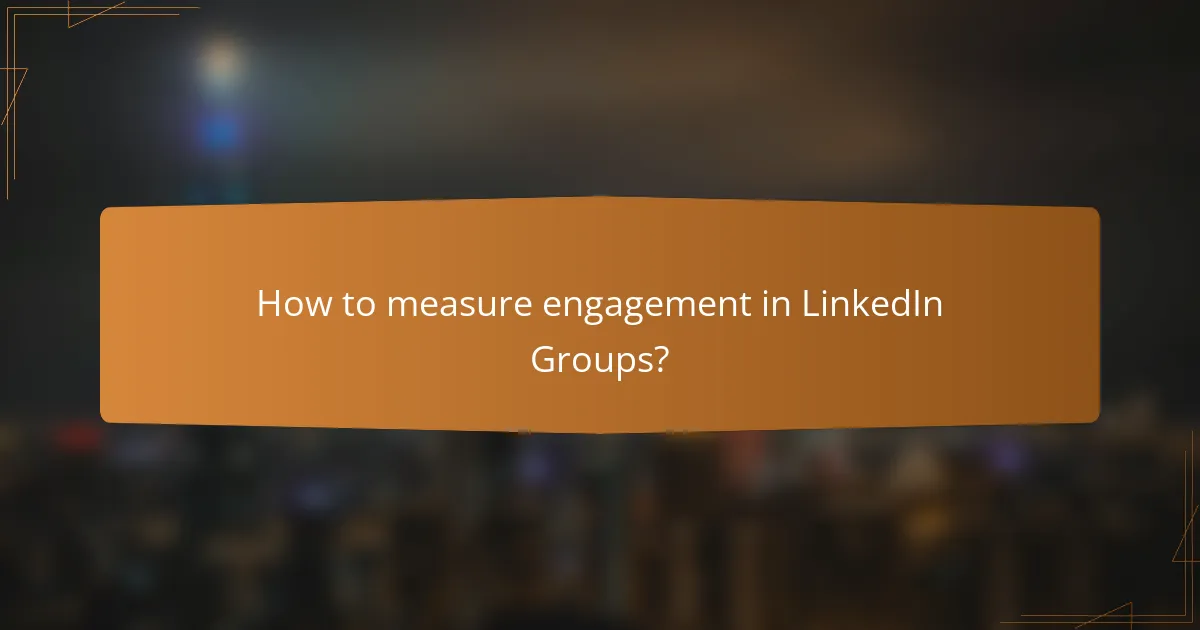
How to measure engagement in LinkedIn Groups?
Measuring engagement in LinkedIn Groups involves assessing how members interact with posts and discussions. Key metrics include the number of likes, comments, shares, and the frequency of member participation.
Track post interactions and comments
Monitoring post interactions and comments is essential for understanding engagement levels in LinkedIn Groups. Each like or comment indicates a member’s interest and can reflect the group’s overall activity. Aim to analyze the average number of interactions per post to gauge what content resonates most with your audience.
Consider categorizing posts based on their themes or topics to identify which subjects generate the most engagement. For example, posts about industry trends may receive more comments than general networking posts. Regularly reviewing these interactions can help refine your content strategy.
To effectively track interactions, use LinkedIn’s built-in analytics tools or third-party social media management platforms. Set benchmarks for engagement, such as aiming for a minimum of 10% interaction rate on posts, to evaluate performance over time.
